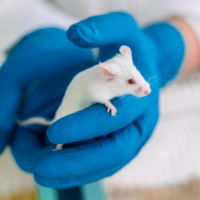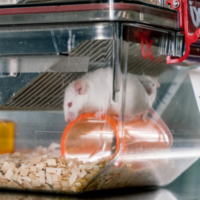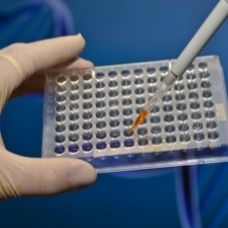Research that is done without laboratory animals, is not automatically 100% animal-free. Just as vegetarian food is not always vegan food. This is because animal materials are often used to keep cells in scientific research alive and growing.
Two commonly used, animal-based materials are FCS and matrigel. On this page you will learn what these materials are, why they are used and how research can be done without them.
What is fetal calf serum (FCS)?
When thinking of a serum, many might think of a skin care product. In medical science however, the word serum is used for the liquid that remains when you coagulate blood (plasma) and then rapidly spin the clot in a centrifuge.
Fetal calf serum means the serum of a calf fetus, or an unborn calf. Sometimes it is also called fetal bovine serum, which means the serum of a bovine fetus.
How is fetal calf serum developed?
A fetus is an unborn human or animal. Concerning cows, we call the unborn calf a fetus after about one month into the pregnancy (a cow’s pregnancy lasts about nine to ten months).
To develop fetal calf serum, the blood of living, unborn calves is used. For example: if a dairy cow is slaughtered at the end of her life and is pregnant at the same time, the unborn calf is used to make the serum. In 2002, researchers estimated that for the worldwide production of fetal calf serum, 1 to 2 million unborn calves per year are used for their blood. Since then, demand has increased even more.
What components does FCS contain?
Fetal calf serum contains many substances that are important for cell growth. These substance include: growth factors, sugars, hormones, proteins and vitamins.
Is it possible to use serums from other animals?
Although serums from other animals are known to be used (e.g. from a horse, rabbit, goat or pig), FCS is most popular. This is because it contains the most growth substances and because it can be used for different types of cells. Serums from adult animals can also be used, but they also contain fewer growth substances.

What is matrigel?
To grow human cells in vitro, scientists use a special gel that mimics the environment of the human body. This gel is called hydrogel and allows the cells to grow in the most realistic way possible. Within scientific research the standard hydrogel is matrigel, a gel made from the tumors of laboratory mice.
How is matrigel developed?
To develop matrigel, millions of mice are bred and killed on a yearly basis. In the laboratory, tumor cells are injected into the small rodents, causing tumors to grow. These artificial tumors are rich in proteins, which are suitable for a hydrogel. To extract the proteins from the tumors, the mice must be killed.
What components does matrigel contain?
Similar to FCS, matrigel contains substances that are important for cell growth. The main components in the gel are the proteins that are also present in the thin fibrous layer called the basal membrane, which is found in most organs. These proteins are called collagen type IV and laminin.

Use of animal-based materials in research
Animal-based materials, such as matrigel and FCS, that help cultivate cells are used in scientific studies to keep cells alive and/or growing in vitro. Without a substance that helps the cells survive, the cells would perish after a few days.
Both FCS and matrigel are used in many research fields, such as biological research and medical research. Specific examples are the use of FCS in stem cell research and vaccine making and the use of matrigel in drug effect research.
Free of laboratory animals, but not animal-free
Fetal calf serum and matrigel can also be used in research that is free of laboratory animals, in order to keep human cells (donated by a patient, for example) alive and growing. Thus, this makes the research free of lab-animals, but not animal-free.
Reasons to discard animal-based materials
Aside from the obvious suffering animals must endure, there are other reasons to question the use of FCS and matrigel.
- Each batch of serum and matrigel is different. After all, there is variation in the animals used, so the ratios are never the same. Thus each batch must be examined and approved. This takes a lot of time, effort and money and undermines the reliability of research results. Regulatory organizations advise against its use for this reason.
- Because FCS is in high demand, manufacturers sometimes dilute it (against regulations) with adult bovine serum, water and other substances. This can affect the quality of the serum.
- FCS and matrigel can be infected with viruses, bacteria and fungi, posing a risk both to the experiments and to the health of researchers.
- With FCS and matrigel, there is limited translatability to humans. Because both culture materials are developed with animal cells.

Alternatives
Fortunately, there are now many alternatives.
- Alternatives to fetal calf serum (FCS)
Researchers at the Univerisity of Utrecht have created a database listing all alternatives to fetal calf serum. One of these alternatives is a fluid in which you can grow cells that is not made from animals, but from artificial material.
- Alternatives to matrigel
Researchers at Radboud University Nijmegen are developing a synthetic hydrogel that mimics the material that surrounds our cells. Because the gel mimics human tissue, the lab team can study the effect of drugs or other substances on these cells in a realistic, human environment.
Even though there are currently drawbacks to artificial alternatives (such as that they are not always suitable for all types of cells), it is important to continue to support their development.

Artificial, human-based materials have the future
As far as we are concerned, the use of FCS and matrigel may become a thing of the past as soon as possible. Fortunately, with today’s knowledge, research without the use of animal-based materials is strongly preferred, also for science.
That is why we are tightening our funding conditions from 2026: we will stop supporting projects that use Fetal Calf Serum (FCS). In this way, we encourage the testing of alternatives and ensure a smooth transition towards truly animal-free research.
Antibodies: lab animal free or not?
Antibodies play a major role in scientific research because they can detect disease-related molecules in blood or tissues, for example. Traditionally, these antibodies are obtained by administering an antigen to animals, such as mice and goats, to induce antibodies. This is comparable to a vaccination. The antibodies are then extracted from the blood for research. In addition to ethical objections, there are also scientific disadvantages to using animal antibodies.
As with FCS and Matrigel, each batch of antibodies is different, which can hinder reliable research results. Fortunately, there are animal-free alternatives, such as synthetic antibodies and antibodies developed in cell culture without animal material. With these new techniques, science continues to develop in a way that is better for animals and humans.
